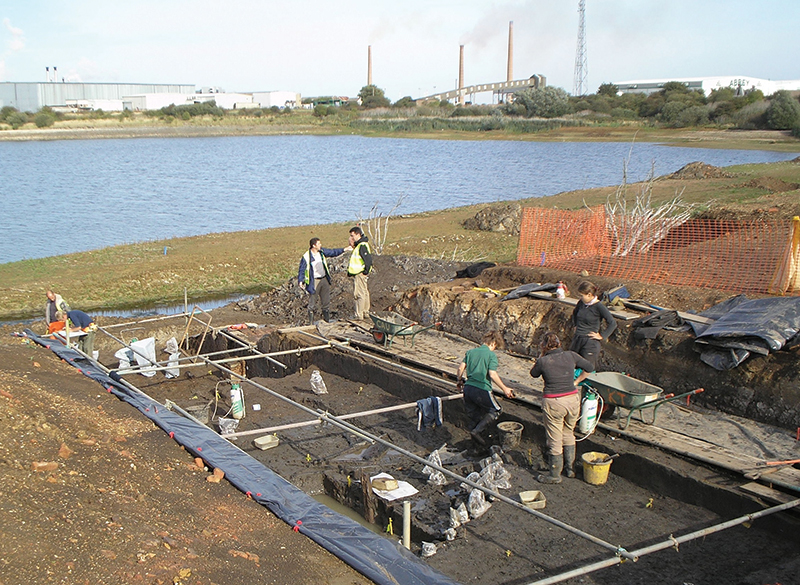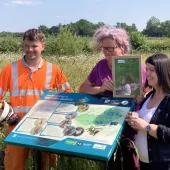Archaeological discoveries at Hanson's Must Farm site

First published in the May 2014 issue of Quarry Management as A new Perspective on the Past
Archaeological discoveries at Hanson’s Must Farm site shed new light on Britain’s Bronze Age
Internationally important discoveries made at Hanson’s Must Farm clay quarry, near Peterborough, have provided archaeologists with a new perspective on Britain’s Bronze Age. The investigations have revealed extraordinary remains of what is thought to be the largest collection of Bronze Age log boats ever found in one place in Britain.
What makes Must Farm so important is the depth at which the team from Cambridge Archaeology Unit (CAU) has been working – up to 6m below the current surface – allowing archaeologists to uncover a complete timeline of British prehistory.
‘Must Farm is changing the way Fenland archaeology is viewed,’ said David Gibson from CAU. ‘It was once regarded as a submerged and therefore barren landscape with little to offer, but the emergence of this ‘deep space’ archaeology is revealing artefacts that are exceptional in both their quantity and quality. It is giving us a three-dimensional articulation of this community that we only see very rarely anywhere in the world, let alone in this country.
‘Usually at a later-Bronze Age period site you get pits, post holes and maybe one or two really exciting metal finds. Convincing people that such places were once thriving settlements takes some imagination. But this time so much more has been preserved.
‘Up until now it has always felt like we had a partially obscured view of Britain’s Bronze Age landscape. Now the picture is becoming much clearer.’
The Fenlands is a submerged landscape made up of sediments that have been shaped by rising sea levels. Over time the area available for settlement became less and less, so each successive occupation was slightly elevated above the last allowing different aspects of the Bronze Age, for example, to occur at noticeably different levels.
The first sign of the site’s untold secrets was the discovery of some decaying timbers protruding from the southern face of the old quarry at Must Farm. Subsequent investigations revealed the site to be later-Bronze Age (1,300–800BC) and made up of a succession of large structures spanning an ancient water course. It seems that a major fire, dating between 920 and 800BC, brought a sudden end to the riverside settlement, plunging the structure and most of its contents into the river, where it was safely encapsulated in layers of organic mud.
Among the most remarkable finds are eight 3,500-year-old boats hollowed out of oak tree trunks, each measuring between 4m and 8.3m in length, one of which appears to be decorated. The boats survived deep within the waterlogged sediments of a 200m stretch of river channel and are in such good condition that the wood grain and colour can still be seen. Indeed, they are the best preserved examples of their type ever to be unearthed.
Along this same stretch CAU also found weirs and woven willow fish traps, as well as metalwork, glass beads and whole pottery vessels. These included a bowl which still had a wooden spoon embedded in its vitrified contents. Most significant are textiles of late-Bronze Age, which have been preserved due to a combination of fire and waterlogged conditions. Given the fragile nature of the remains, and the rareness of their discovery, Hanson have sealed the site with clay bunds and undertake regular water and oxygen monitoring to ensure their ongoing preservation.
Two iron swords were also recovered about 7m apart, seemingly cast into the river, with their wooden handles and scabbards still intact. Other prehistoric weapons have been found including a complete Bronze Age spear still with its long wooden shaft and metal tip.
The log boats have now been moved into a refrigerated unit at the Flag Fen heritage centre, near Peterborough, to start a two-year conservation process. They will be conserved using the same techniques pioneered for the Mary Rose, which involves them being carefully dried then sprayed with wax to stabilize their fragile ancient timbers. In the past log boats have been cut into pieces for conservation.
Conservationists at Flag Fen received a £100,000 grant from English Heritage to construct a refrigerated store to house the vessels. The waterlogged boats need to be kept cold to prevent them drying out too quickly and, at the same time, treated with a specialist polyethylene glycol wax, to stabilize the timbers. The boats can be viewed through glass panels and have attracted interest from national and international media.
Must Farm Quarry supplies Lower Oxford Clay to Hanson’s adjoining Kings Dyke brick works. The archaeological investigations are being carried out by CAU as part of a planning condition to extend the quarry. The programme is being managed for Hanson by environmental specialists SLR Consulting.
Must Farm is a working quarry so public access is not possible. Instead, Hanson and CAU have developed a website (www.mustfarm.com) containing photographs and explanations supported by short videos of the excavation.
- Subscribe to Quarry Management, the monthly journal for the mineral products industry, to read articles before they appear on Agg-Net






